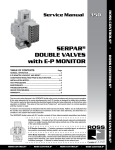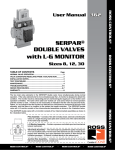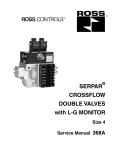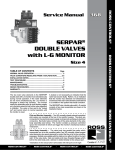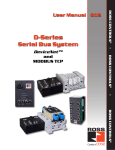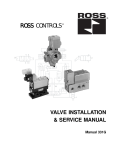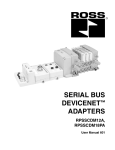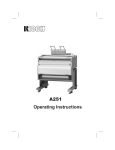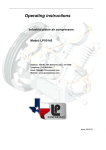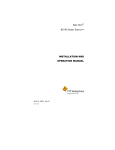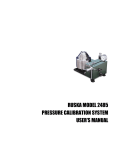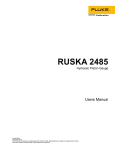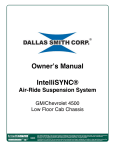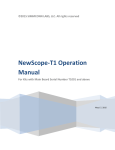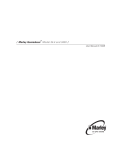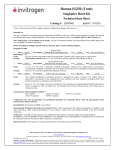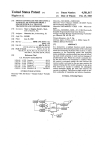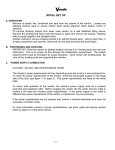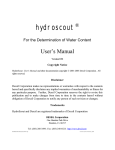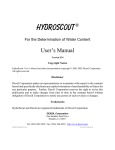Download SERPAR® CROSSFLOW DOUBLE VALVES with
Transcript
ROSS CONTROLS ® SERPAR® CROSSFLOW DOUBLE VALVES with D-S MONITOR Service Manual W358C TABLE OF CONTENTS Page INTRODUCTION.............................................................................................2 VALVE OPERATION Normal Valve Operation...........................................................................3 Valve Conditions Resulting From a Malfunction..................................4 INSTALLATION NOTES..................................................................................5 TEST PROCEDURE.......................................................................................6 MAINTENANCE..............................................................................................6 TROUBLESHOOTING....................................................................................7 REPAIR PROCEDURES........................................................................... 8-11 CAUTIONS....................................................................................................11 WARRANTY..................................................................................................12 INTRODUCTION The SERPAR® Crossflow double valve has two main valve elements that move quickly and simultaneously during normal operation. If either valve element fails to move or moves too slowly, the D-S monitor is designed to detect this condition. It then disconnects the electrical power to the pilot solenoids, thereby inhibiting further valve operation. The valve is then said to be “locked out” and cannot return to normal operation until the monitor is reset. A lock-out is not necessarily an indication that the valve has become faulty. Rather, it is an indication that the monitor has detected slow movement of one or both of the main valve elements, and that there is a condition in the system that needs correction. The SERPAR® Crossflow double valve with D-S monitor consists of four interconnected assemblies as shown inthe illustration below. Pilot Assembly – Consists of two 3/2 normally closed, solenoid-controlled pilot valves in a single housing. Each pilot valve controls one of the valve elements in the valve body assembly. Valve Body Assembly – A valve body having parallel flow paths including two in-to-out crossflow paths, two 3/2 normally closed poppet valve elements, plus spool elements to control air flow in the crossflow passages. A silencer is bolted directly to the exhaust port. Pressure Indicator Assembly – Contains two pistons actuated by monitoring air pressures. D-S Monitor Assembly – Consists of an encapsulated electronic module with two proximity switches, monitoring circuitry, and a terminal strip, all enclosed in an aluminum housing. 2 ROSS CONTROLS® NORMAL VALVE OPERATION CONDITIONS AT START Inlet air is blocked from the outlet by the two normally closed valve elements “A” and “B” (see Figure 1). The outlet port 2 is connected to the exhaust port 3. Pilot supply air is carried via passage 4 and supplies the two 3/2 normally closed, solenoid controlled pilot valves “F”. SOLENOIDS ENERGIZED Simultaneously energizing the two solenoids “a” and “b” (see Figure 2) causes the two pilot poppets “E” to shift and close pilot exhaust passages. The open pilots allow pilot air to move via passages 5 to the main valve piston poppets “J”. Pressure on the piston poppets causes the main valve elements to shift, closing off exhaust port 3. At the same time, the inlet port 1 is opened to outlet port 2 via crosflow passages 10 and 11. As the main valve poppets “U” and “V” open, monitoring passages 6 are opened to inlet pressure. This pressure is directed to the two pressure indicator pistons “K” and “L” via monitoring air passages 6. As the pistons are actuated, the indicator pins “C” and “D” extend into the magnetic fields of the proximity switches “W” and “X”. Signals from the proximity switches are interpreted by the monitor’s circuitry. Because each pair of solenoids, pilot valves, main valve elements, and pressure indicators has responded in unison, the signals generated by the proximity switches ”W” and “X” will also be in unison. The monitor then reads these signals as “normal valve operation.” Figure 1 — Solenoids Not Energized SOLENOIDS DE-ENERGIZED Simultaneously de-energizing solenoids “a” and “b” allows the two pilot poppets “E” to return to their normally closed positions. Pilot pressure on the main valve pistons “J” is exhausted through the main exhaust port 3 via internal exhaust passages. Main valve piston poppets “J” and inlet poppets “U” and “V” return to their normal positions. Main valve inlet air is again blocked by poppets “U” and “V”. Pressure at outlet port 2, at pressure indicator pistons “K” and “L,” and in monitoring passages 6 is exhausted through exhaust port 3. This completes the normal operating cycle, and the valve is returned to the CONDITIONS AT START described above. Figure 2 — Solenoids Energized www.rosscontrols.com 3 VALVE CONDITIONS RESULTING FROM A MALFUNCTION DURING A MALFUNCTION Due to a mechanical or electrical malfunction, one of the valve elements may not respond to the energizing signal, or alternatively, may not return to its normal position after the signal is removed. In either case, there is a condition such as depicted in Figure 3 — one valve element closed and one open. Inlet air flowing past open inlet poppet U and into crossflow passage 10 is practically blocked by spool H on valve element “B”. Although some air can pass around spool ”H”, the amount is so small and the exhausting capacity of the valve so large that the pressure at outlet 2 will not exceed two percent of inlet pressure. At the same time a monitoring air signal to pressure indicator K via passage 6 causes the indicator pin “C” to be extended and actuate proximity switch W. When the time interval between the signal to a solenoid and the signal from its corresponding proximity switch exceeds the design limit of approximately 175 milliseconds, the D-S monitor will break the solenoid supply circuits as soon as solenoid power is removed. Therefore, the solenoids cannot be re-energized and the valve is made inoperative. The valve is said to “locked out” because it cannot be returned to normal operation until the D-S monitor is reset. If the exhaust silencer becomes clogged, the valve elements may move more slowly than normal. The monitor will detect this condition and produce a lockout even though the valve elements may be moving simultaneously as they should. It does this by measuring the time interval between the signal to each solenoid and the signal from the corresponding proximity switch, both on actuation and deactuation. If this interval exceeds 175 milliseconds, the monitor breaks the supply circuits to the solenoids, thereby producing a lockout. Note that on actuation the lockout does not occur until solenoid power is removed. Figure 3 – Faulted Mode: One Valve Element Open and One Closed Terminals are provided on the monitor for the connection of an external fault indicator (see Figure 5). The fault indicator terminals are internally connected when a lockout occurs or when power for the monitor is interrupted. FOLLOWING A LOCKOUT With the electrical circuits to the solenoids broken by the lockout, the pilot poppets “E”, the main inlet poppet “U”, and the pressure indicator piston “K” return to their deactuated positions. Inlet pressure is thereby completely blocked from the outlet. However, if an inlet poppet remains open or partially open (perhaps due to foreign material on the poppet seat), outlet pressure remains at no more than two percent of inlet pressure. The smallness of this outlet pressure is due to the blocking effect of the spools “G” and “H”, plus the large exhausting capacity of the valve. RESETTING THE D-S MONITOR Following a lockout, the monitor must be reset before another valve cycle can be initiated. To reset the monitor, an external reset switch must be momentarily closed, then opened. Reset will occur after a delay of approximately two seconds. However, as a safety precaution, reset cannot occur if the solenoid supply circuits are energized (voltage greater than 4.0 volts). Reset can also be accomplished by momentarily interrupting the power supply to the monitor. CAUTION: Interrupting power to the monitor will accomplish a reset whether or not the supply circuits to the solenoids are energized. If reset is to be performed in this way, care must be taken to be sure that the solenoids are de-energized so that the valve does not immediately cycle and produce a potentially hazardous condition. 4 ROSS CONTROLS® Figure 4 – All Elements Returned to De-actuated Positions After Lockout, but Electrical Supply Circuits Remain Open INSTALLATION NOTES Pneumatic equipment should be installed only by persons trained and experienced in the installation of such equipment. Air Lines. Before installing a ROSS double valve in an existing system, the air lines must be blown clean of all contaminants in the system. Experience has shown that one of the leading causes of lockouts is foreign material from the air lines which becomes lodged in the valve. It is strongly recommended that an air filter be installed ahead of and close to the double valve. Valve Inlet 1. See Figure 6. DO NOT RESTRICT AIR SUPPLY. Any restriction of the air supply lines (for example, sharp bends or undersized lines) will reduce the speed with which the outlet volume is pressurized. A restricted air supply can produce nuisance lockouts. See Inadequate Air Supply, page 8. Valve Outlet 2. For faster pressurizing and exhausting of the outlet volume, locate the valve as close as possible to the mechanism being operated. Also, avoid restrictions in the outlet lines. Valve Exhaust 3. DO NOT RESTRICT THE EXHAUST. Limiting the exhausting speed decreases an important safety feature of the double valve. During a malfunction in which only one of the valve elements has shifted, air escaping past the spool in the valve stem of the closed valve element (see Figure 4) must be quickly exhausted to keep outlet pressure at or below two percent of inlet pressure. Therefore, only a properly sized and designed silencer should be used. See CAUTION on page 9. on the label affixed to the pilot housing. A supply voltage that does not fall within this range can cause nuisance lockouts or premature solenoid burnout. If electrical power is supplied by a transformer, it should be capable of handling the inrush current of the solenoids without a significant voltage drop. Power is supplied to solenoid “a” via terminals ”A” and “B” (see Figure 5 below), and to solenoid “b” via terminals “C” and “D”. The solenoids may be wired independently or in parallel. The solenoid voltage should match the monitor voltage. Monitor Electrical Supply. Power is supplied via terminals ”E” and “F”. A label on the monitor gives the electrical power requirements: 120 VAC or 24 VDC. Monitor Reset. An external switch for the reset function is connected to the monitor at terminals “G” and “H”. The reset switch should be normally-open & momentary. CAUTION: Do NOT apply power to the reset terminals ”G” and “H”. To do so would damage the monitor. Fault Indicator. An external fault indicator (a light, for example) can be connected through terminals “J” and “K”. These terminals are internally connected when the monitor is faulted or when monitor power is off. A maximum current of 5 amperes is allowable through these terminals. Mounting Position. It is recommended that double valves be mounted with the pilot assembly at the top whenever possible. Pressure Range. The SERPAR® Crossflow double valve with D-S monitor has an operating inlet pressure range of 30 to 100 psig (2 to 7 bar). Pressure below 30 psig (2 bar) will reduce the speed of pressurizing the outlet line, and can cause the valve elements to respond erratically, and lead to intermittent lockouts. Pressure above 100 psig (7 bar) will produce excessive poppet impact during operation, thereby shortening the life of the valve. Temperature Range. The operating media (usually air) tem-perature range is 40°F to 175°F (4°C to 80°C), and the ambient temperature range is 40°F to 120°F (4°C to 50°C). Shortening of valve life can result if these temperature limits are not observed. Solenoid Electrical Supply. It is very important that the electrical supply match the voltage and frequency of the monitor supply. ROSS solenoids are rated for continuous duty at 85 percent to 110 percent of the voltage shown www.rosscontrols.com Figure 5 – D-S Monitor; 120 VAC Unit Illustrated; 24 VDC Unit also Available. 5 TEST PROCEDURES ROSS valves are tested after assembly to assure proper operation, but it is recommended that the following tests be made when the valve is initially installed, or whenever the valve has been disassembled. These tests should be made at the repair bench and at the installation. At the installation, take normal press operation safety precautions during these tests to avoid the potential for personal injury or damage to equipment. All tests should be performed only by persons trained and experienced in the testing of pneumatic equipment. Before beginning these tests, make the electrical connections outlined in the Installation Notes on page 5. These tests call for the use of the manual overrides. If your valve is not so equipped, use the corresponding solenoids instead. This will require wiring the solenoids so that they can be individually energized. If the valve fails any of the following tests refer to Troubleshooting on page 7. 1. Remove silencer. Apply compressed air in the 30 to 100psig (2 to 7 bar) range to inlet port 1 (see Figure 6). There should be no pressure at outlet port 2 or exhaust port 3. 2. Connect outlet port 2 to a small volume (25–50 cubic inches) fitted with a damped pressure gauge. Simultaneously energize both pilot solenoids. Inlet and outlet pressures should be equal. There should be no leakage at the exhaust port. De-energize both solenoids. 3. Simultaneously energize both pilot solenoids, then depress manual override “N” (Figure 6). De-energize both solenoids while holding override “N” depressed. There should be a small flow of exhaust air. Release the manual override. Exhaust air flow should stop. 4. Try to energize both pilot solenoids. The procedure instep 3 should have caused the D-S monitor to lock out sothat it is not possible to energize the solenoids. No pressure should appear at either the outlet or exhaust port. Turn off the electrical supply to the pilot solenoids. 5. Reset the monitor (see page 5). Simultaneously energize both pilot solenoids. Inlet and outlet pressures should be equal. There should be no leakage at the exhaust port. De-energize both solenoids. 6. Simultaneously energize both pilot solenoids, then depress manual override “P”. De-energize both solenoids while holding override “P” depressed. There should be a small flow of exhaust air. Release the manual override. Exhaust air flow should stop. 7. Try to energize both pilot solenoids. The procedure instep 6 should have caused the D-S monitor to lock out so that it is not possible to energize the solenoids. No pressure should appear at either the outlet or exhaust port. Turn off the electrical supply to the pilot solenoids. 8. Repeat step 5. 9. Re-install silencer. Valve is ready for normal operation. MAINTENANCE Pneumatic equipment should be maintained only by persons trained and experienced in the maintenance of such equipment. Supply Clean Air. Foreign material lodging in valves is a major cause of breakdowns. The use of a 5-micron-rated air filter located close to the valve is strongly recommended. The filter bowl should be drained regularly, and if its location makes draining difficult, the filter should be equipped with an automatic drain. Check Lubricator Supply Rate. A lubricator should put a fine oil mist into the air line in direct proportion to the rate of air flow. Excessive lubrication can cause puddling in the valve and lead to malfunctions. For most applications an oil flow rate in the lubricator of one drop per minute is adequate. (Note that the double valve itself does not require air line lubrication.) Compatible Lubricants. Although this valve does not require air line lubrication, it may be used with lubricated air being supplied to other mechanisms. Some oils contain additives that can harm seals or other valve components and so cause the valve to malfunction. Avoid oils with phosphate additives (e.g.,zinc dithiophosphate), and diester oils; both types can harm valve components. The best oils to use are generally petroleum base oils with oxidation inhibitors, an aniline point between 180°F (82°C) and 220°F (104°C), and an ISO 32 or lighter viscosity. Some compatible oils are listed above at the right. These oils, although believed to be compatible, could change without notice because manufacturers sometimes reformulate their oils. Therefore, use oils specifically compounded for air line service. If it is a synthetic oil, contact the oil manufacturer for compatibility information. Cleaning the Valve. If the air supplied to the valve has not been well filtered, the interior of the valve may accumulate 6 COMPATIBLE LUBRICANTS MAKER BRAND NAME Amoco............................. American Industrial Oil 32 Amoco Spindle Oil C Amolite 32 Citgo................................ Pacemaker 32 Exxon............................... Spinesstic 22 Teresstic 32 Mobil................................ Velocite 10 Non-Fluid Oil.................... Air Lube 10H/NR Shell................................. Turbo T32 Sun.................................. Sunvis 11; Sunvis 722 Texaco............................. Regal R & O 32 Union............................... Union Turbine Oil dirt and varnish which can affect the valve’s performance. Although very tolerant of dirty air, the valve may sometimes need cleaning. To clean the valve use any good commercial solvent orkerosene. Do not use a chlorinated solvent or abrasive materials. The former damages seals, and abrasives can do permanent damage to metal parts. Before reassembling the valve, lubricate all sliding surfaces with a grease such as Dow Corning BR-2. Electrical Contacts. In the electrical circuits associated with the valve solenoids, keep all switches or relay contacts in good condition to avoid solenoid malfunctions. Replace Worn Components. In most cases it is not necessary to remove the valve from its installation for servicing. However, turn off the electrical power to the valve, shut off the air supply, and exhaust the air in the system before beginning any disassembly operation. ROSS CONTROLS® TROUBLESHOOTING The SERPAR® Crossflow double valve with D-S monitor is designed to monitor the outlet pressures of the main valve elements, and the electrical signals to the solenoids. If the valve elements move too slowly or fail to move simultaneously, the monitor is designed to detect this condition, act to shut down the valve, and thus inhibit further operation. This is called a “lockout,” but is not necessarily an indication that the valve is faulty. Rather, it indicates that the monitor has detected incorrect movement of the main valve elements, and that there is a condition in the system that needs correcting. Troubleshooting involves finding and correcting the condition that caused the lockout. Troubleshooting should be done only by persons trained and experienced in the servicing of pneumatic equipment. If the troubleshooting is done at the installation instead of the repair bench, take normal press operation safety precautions to avoid personal injury or damage to equipment. The Troubleshooting Chart below can serve as a guide to locating and correcting malfunctions. After the valve is repaired, it should be tested by following the Test Procedure on page 6. If valve operation is still abnormal, repeat the troubleshooting procedure or call ROSS in the U.S.A. at 1-888-TEK-ROSS for assistance. Figure 6 – External Ports and Overrides N, P C 1 2 3 13 Manual overrides Reset Solenoid Inlet Port Outlet Port Exhaust Silencer Electrical Conduit Port TROUBLESHOOTING CHART If the valve locks out, look for the Symptoms described in the first column. Possible Causes are given in the second column, and Repair Procedures in the third column. Repair Procedures are detailed on the following pages. After repairs are made, follow the Test Procedure on page 5 before returning the valve to service. REPAIR SYMPTOMS POSSIBLE CAUSES PROCEDURES Valve locks out intermittently. Inadequate air supply volume A Inadequate voltage at one or both solenoids B Sluggish pilot valve D Main inlet poppet not sealing G Transient foreign material in valve E Varnish deposits in valve H Excessive lubrication L Dirty or undersize silencer F Leaking piston poppet seal J Leaking pressure indicator seal K Stuck indicator pin M Valve locks out on first cycle Consider all of the above possible causes — after monitor is reset. Faulty solenoid C Leaking pilot poppet D Loose pilot cover C Monitor will not reset. Metal particles activating proximity switch N Solenoid control circuit energized: voltage> 4.0 V P Jammed solenoid plunger C Stuck indicator pin M Transient foreign material in valve E Main inlet poppet not sealing G Faulty monitor P www.rosscontrols.com 7 REPAIR PROCEDURES A INADEQUATE AIR SUPPLY VOLUME Even though the air supply pressure is in the correct 2 to 7 bar (30 to 100 psig) range, the air volume supplied can be too little. An inadequate air supply volume causes an excessive pressure drop during valve actuation. Pilot air supply is sufficient to unseat the main valve elements, but the pressure drop resulting from filling the outlet volume depletes the pilot air supply. The main valve elements may be only partially actuated, or may reach the fully actuated position more slowly than normal. The lowered pilot pressure can also exaggerate the effects of small differences in the operating characteristics of pilots and valve elements so that the valve elements may not move simultaneously. Any of these abnormal movements of the valve elements will be sensed by the D-S monitor and result in a lockout. A marginal air supply may result in only intermittent lockouts, but a severely restricted air supply can produce a lockout on each valve cycle. Check for very long, undersize, or pinched supply lines, sharp bends, and restrictive fittings. All can reduce the air supply volume. Of course, the air volume supplied can also be insufficient if more pneumatic devices are connected to a circuit than the compressor is designed to serve. B INCORRECT VOLTAGE AT SOLENOIDS Solenoids are rated for continuous duty at 85 percent to 110 percent of the voltage shown on the pilot housing. A supply voltage that does not fall within this range can cause nuisance lockouts, premature solenoid burnout, or impact damage. To check the electrical supply, first remove the switch box cover at the bottom of the valve. Attach voltmeter leads to terminals “A” and “B” (see Figure 5). Read the voltmeter while the solenoids are energized. Repeat for terminals “C” and “D”. If the voltage falls below the allowable operating range, the electrical supply is inadequate, even though the supply voltage might be correct without the solenoid load. A voltage that exceeds the allowable maximum can cause premature solenoid burnout, loss of air gap due to impact damage, or a stuck solenoid plunger. See Repair Procedure C below. C FAULTY SOLENOID OPERATION Before removing solenoids for inspection, check the following: Loose pilot cover Q (Figure 8). A loose pilot cover can give the symptoms of a defective solenoid because it prevents full travel of one of both pilot valves. However, the valve can operate normally if manual actuation is used. This is because the gap between solenoid and pilot valve is closed by the pressure of manual actuation. If loose, tighten the cover and check for normal valve operation. Jammed solenoid plunger. Great overheating or delamination of the plunger can cause it to jam. A solenoid with such damage must be replaced. Defective solenoid coil. Check the resistance of each coil with an ohmmeter. A coil is defective if resistance is zero or infinite. The most common cause of solenoid burnout is incorrect supply voltage. See Repair Procedure B. If the coils are not defective, examine the solenoids for the following conditions. Broken shading coil. See “S”, Figure 7. Copper shading coils reduce the solenoid’s tendency to buzz when operated on alternating current. If a shading coil is loose or broken, the solenoid must be replaced. Wear that causes a loss of air gap. There must be a small gap between the solenoid plunger and the field frame when the solenoid is energized. See air gap 15, Figure 7. If significant wear is apparent in areas 16, the air gap can be lost and the solenoid will buzz loudly when energized. With this much wear, the solenoid should be replaced. Lubrication will help to prolong solenoid life by preventing some of the above troubles. Solenoids should be lubricated periodically with a lithium based grease. Put grease on the plunger and all impact surfaces. D FAULTY PILOT INSERT Shut off electrical power to solenoids; shut off, exhaust, and lock out the air supply. Disassemble pilot section in the following way: 1. Remove pilot cover “Q” (Figure 8). 2. Slip leads off solenoid tab terminals and lift out both solenoids. To check solenoids see Repair Procedure “C”. 3. Remove pilot body from valve body. 4. Remove rubber cushions “CA” from tops of pilot insert assemblies. 5. With Truarc type pliers, remove retaining rings “CB”. 6. Remove inserts by grasping them at the shoulder area and pulling with a circular motion. Removing inserts by pulling on the spring or stem may damage the inserts. 7. Be sure that poppet return springs “CC” are remove from insert cavity. Check action of each insert by pressing lightly on the spring protruding from the top. It should move easily with light finger pressure and should not jerk or grab during its travel (approximately .03 inch). It does not perform smoothly, the insert must be replaced. 16 S If operation remains abnormal, turn off the electrical power to the solenoids, remove the pilot cover, remove both solenoids and check for the following: 8 ROSS CONTROLS® 15 Figure 7 – Solenoid REPAIR PROCEDURES Q CA CB CA CB F E CC 9 5 F E CC 5 Figure 8 – Cross-section of Pilot Section Inspect the poppets “E” and their seats for foreign particles or damage. Carefully clean out foreign material. If the poppets are swollen or have deteriorated, improper lubricants may be the cause. Be sure to use only compatible lubricants as described on page 6. If a poppet or inlet (upper) seat is worn or defective, the pilot insert must be replaced. Before installing a new insert, blowout pilot air passages 5 and 9 to remove any loose dirt particles. E TRANSIENT FOREIGN MATERIAL If the valve resumes normal operation after being reset, the cause of the lockout may have been a transient foreign particle. A bit of scale or other foreign material could lodge at various points in the valve to cause a lockout. After resetting, the air flow of the next operating cycle can “wash” the foreign material out so that the valve continues to operate normally. This situation is most common after a period of press inactivity. An efficient and well maintained filter close to the valve can help to eliminate this problem. A stubborn bit of foreign material can also prevent the monitor’s being reset. Using the manual overrides, cycle the valve several times. If the monitor still cannot be reset, it will be necessary to disassemble the valve for cleaning. If a silencer other than the ROSS SERPAR® silencer is used, be sure that it is of the correct capacity. Otherwise, excessive back pressure may be immediately present and cause sluggish operation of the valve. If a valve locks out intermittently but performs normally when the silencer is removed, clean the silencer or replace it with one of the correct capacity. G MAIN INLET POPPET NOT SEALING If one of the inlet poppets is not sealing, air can be detected escaping at the exhaust port. Foreign particles are sometimes responsible for holding a poppet off its seat. Manually cycle the valve several times to see if the flow of air through the valve will flush out the particles. Take normal press operation safety precautions during this procedure to avoid injury or damage to equipment. If cycling does not clear the valve, it will be necessary to disassemble and clean the valve. To disassemble the valve, first turn off the electrical power to the valve. Shut off, exhaust, and lock out the air supply. Remove the pilot assembly, D-S monitor and housing, and pressure indicator assembly. ROSS expressly disclaims all warranties and responsibility for any unsatisfactory performance or injuries caused by the use of he wrong type, wrong size, or inadequately maintained silencer installed with a ROSS product. Disassembly Note. Before removing the pilot assembly the solenoid leads must be slipped off the solenoid terminals. When removing the monitor housing, exercise care in with-drawing the solenoid leads from the passage through the valve body. To remove the valve elements, first remove the snap rings ”M” (Figure 9), end plugs “Y”, and springs “Z” at the lower ends of the bores. Pull inlet poppets “U” and “V” off the valve stems, and remove the remaining parts of the valve elements through the top of the valve body. If the inlet poppets “U” and “V” are damaged or have deteriorated, replace them. Deteriorated poppet material suggests the use of incompatible lubricants. Only lubricants such as those described on page 6 should be used. The silencer supplied with SERPAR® Crossflow double valves is designed to create minimum back pressure. However, after long usage with contaminant-laden air it may become clogged. The increased back pressure can then cause erratic motion of the valve elements and lead to While the valve is disassembled, also inspect the piston poppets J for damage or deterioration. Inspect the bores for varnish deposits or excess wear. See Repair Procedures H and J. Lightly lubricate moving parts and re-assemble the valve. F UNDERSIZE or PLUGGED SILENCER CAUTION: Restricting the exhaust port of a double valve can adversely affect its operation and create the potential for injury. Silencers must be resistant to clogging and have a flow capacity greater than the exhaust capacity of the valve. Silencers supplied by ROSS satisfy these criteria. intermittent lockouts. A dirty silencer should be removed and cleaned with a water soluble detergent solution. www.rosscontrols.com 9 REPAIR PROCEDURES Figure 9 – Cross-section of Valve Body and Pressure Indicator Assembly H VARNISH DEPOSITS Varnish deposits in the valve may affect the movement of a piston and cause intermittent lockouts. Varnish results from the action of oxygen on lubricating oils and can be aggravated by excess heat. Varnish can also come from overheated compressor oil carried over into the air lines and deposited in the valve. To disassemble for cleaning, first turn off electrical power to the valve. Shut off the air supply and exhaust the air in the system. Remove the pilot assembly, monitor and housing, and pressure indicator assembly. See Repair Procedure K and Disassembly Note in Repair Procedure G. Use a water soluble detergent for cleaning varnished areas. Avoid chlorinated solvents and abrasive materials. The former can damage seals and poppets, and abrasives can do permanent damage to metal parts. Inspect all components for wear or damage. lubricate moving parts before re-assembling. Lightly J LEAKING PISTON POPPET SEAL A worn or damaged piston poppet seal T (see Figure 9) can allow pilot pressure to leak past the piston and cause erratic valve action and intermittent lockout. Disassemble to inspect seals. See Disassembly Note in Repair Procedure G. When installed, the seals should have some compression in the bore. It is advisable at this time also to inspect for varnish deposits, and wear or damage to piston and inlet poppets and their seats. Replace poppets and/or seals if damaged or worn. If the seals show signs of deterioration, incompatible lubricants or solvents may be the cause. See information about compatible lubricants and cleaning on page 6. K LEAKING PRESSURE INDICATOR SEAL A leaking pressure indicator seal “ PA” (see Figure 9) can cause the pressure indicator to respond too slowly, thereby causing a lockout. To disassemble for inspection, first turn off the electrical powerto the valve. Shut off the air supply and exhaust the air in the system. Remove 10 monitor and housing. See Disassembly Note in Repair Procedure G. Remove end caps ”PB” and springs “PC” at bottom of pressure indicator assembly. Pull out pressure indicator pistons “K” and “L”, and inspect seals for wear or damage. Also inspect piston bores for varnish deposits. Clean bores and replace seals as necessary. Lightly lubricate bores and re-assemble. Pistons should move smoothly in bores when re-inserted. L EXCESSIVE LUBRICATION Excess oil on the piston walls can sometimes cause erratic valve action and result in intermittent lockouts. Although lubrication is not required for this valve, if a lubricator is used it should deposit only a thin film of oil on the piston walls. Check lubricator in supply line; it may be injecting too much oil for the existing rate of air flow. Remove excess oil and re-assemble valve. Check lubricator flow rate (see page 6). M STUCK INDICATOR PIN If an indicator pin is stuck in the de-actuated position, the monitor will lock the valve out on the first cycle following reset. Each reset is followed by a lockout. If an indicator pin is stuck in the actuated position, the monitor will lock the valve out, but it will not be possible to reset the valve. By removing the cover of the monitor housing the movement of the indicator pins can be observed as each of the manual overrides is depressed. If either pin is stuck, it will be necessary to disassemble the pressure indicator assembly. See Repair Procedure K for disassembly instructions. N METAL PARTICLES IN MONITOR HOUSING Whenever the monitor housing cover is removed, care must be taken to prevent chips or other bits of metal from entering the enclosure. Loose bits of metal in the housing can trigger the proximity switches “W” and “X”. This can cause one or both switches to remain actuated so that themonitor will indicate a fault and will not reset. ROSS CONTROLS® REPAIR PROCEDURES P MONITOR WILL NOT RESET If the monitor indicates a fault but will not reset, the monitor may be defective. However, all other possible mechanical and electrical malfunctions should be checked before concluding that the monitor is defective. Refer to Repair Procedures C, G, M, and N particularly. Verify that the solenoid control circuit is not energized. If it is energized, the monitor cannot be reset. To be certain, remove the monitor housing cover and check with a voltmeter at terminals “A-B” (see Figure 5) and “C-D”. If a voltage is present at either pair of terminals there is a defect in the external solenoid control circuit. Pull-down resistors (10K ohms, 2 watts) can be used to eliminate leakage current from solid state switches. Resistors would be connected across terminals “A-B” and “C-D”. With the solenoid control circuit de-energized, cycle the valve several times by using the manual overrides. Take normal press operation safety precautions during this test to avoid personal injury or damage to equipment. If the monitor cannot be reset, the monitor is defective and must be replaced. CAUTIONS PRE-INSTALLATION or SERVICE 1. Before servicing a valve or other pneumatic component, besure that the electrical supply is turned off, the entire pneumatic system is shut off and exhausted, and all power sources are locked out. 2. All ROSS products, including service kits and parts, should be installed and/or serviced only by persons having training and experience with pneumatic equipment. Because any installation can be tampered with or need servicing after installation, persons responsible for the safety of others or the care of equipment must check every installation on a regular basis and perform all necessary maintenance. 3. All applicable instructions should be read and complied with before using any fluid power system in order to prevent harm to persons or equipment. In addition, overhauled or serviced valves must be functionally tested prior to installation and use. 4. Each ROSS product should be used within its specification limits. In addition, use only ROSS parts to repair ROSS products. Failure to follow these directions can adversely affect the performance of the product or result in the potential for human injury. FILTRATION and LUBRICATION 5. Dirt, scale, moisture, etc. are present in virtually every air system. Although some valves are more tolerant of these contaminants than others, best performance will be realized if a filter is installed to clean the air supply, thus preventing contaminants from interfering with the proper performance of the equipment. ROSS recommends a filter with a 5-micron rating for normal applications. 6. All standard ROSS filters and lubricators with polycarbonate plastic bowls are designed for compressed air applications only. Do not fail to use the metal bowl guard, where provided, to minimize danger from high pressure fragmentation in the event of bowl failure. Do not expose these products to certain fluids, such as alcohol or liquefied petroleum gas, as they can cause bowls to rupture, creating a combustible condition, hazardous leakage, and the potential for human injury. Immediately replace a crazed, cracked, or deteriorated bowl. When bowl gets dirty, replace it or wipe it with a clean dry cloth. 7. Only use lubricants which are compatible with materials used in the valves and other components in the system. Normally, com-patible lubricants are petroleum base oils with oxidation inhibitors, an aniline point between 180°F (82°C) and 220°F (104°C), and an ISO 32, or lighter, viscosity. Avoid oils with phosphate type addi-tives which can harm polyurethane components, potentially lead-ing to valve failure and/or human injury. AVOID INTAKE/EXHAUST RESTRICTION 8. Do not restrict the air flow in the supply line. To do so could reduce the pressure of the supply air below the minimum require-ments for the valve and thereby cause erratic action. 9. Do not restrict a poppet valve’s exhaust port as this can adversely affect its operation. Exhaust silencers must be resistant to clogging and have flow capacities at least as great as the exhaust capacities of the valves. Contamination of the silencer can result in reduced flow and increased back pressure. ROSS expressly disclaims all warranties and responsibility for any unsatisfactory performance or injuries caused by the use of the wrong type, wrong size, or inadequately maintained silencer in-stalled with a ROSS product. POWER PRESSES 10. Mechanical power presses and other potentially hazardous machinery using a pneumatically controlled clutch and brake mechanism must use a press control double valve with a monitoring device. A double valve without a self-contained monitoring device should be used only in conjunction with a control system which assures monitoring of the valve. All double valve installations involving hazardous applications should incorporate a monitoring system which inhibits further operation of the valve and machine in the event of a failure within the valve mechanism. ENERGY ISOLATION/EMERGENCY STOP 11. Per specifications and regulations, ROSS L-O-X® and L-O-X/EEZ-ON® products are defined as energy isolation devices, NOT AS EMERGENCY STOP DEVICES. www.rosscontrols.com 11 GLOBAL Reach with a LOCAL Touchsm ROSS EUROPA® GmbH ROSS CONTROLS® Langen, Germany Telephone: + 49-6103-7597-0 Fax: + 49-6103-74694 Email: [email protected] www.rosseuropa.com Troy, MI., U.S.A. Telephone: + 1-248-764-1800 Fax: + 1-248-764-1850 In the United States: Safety Department: 1-248-764-1816 Customer Service: 1-800-GET ROSS (438-7677) Technical Service: 1-888-TEK-ROSS (835-7677) www.rosscontrols.com ROSS ASIA® K.K. Kanagawa, Japan Telephone: + 81-427-78-7251 Fax: + 81-427-78-7256 www.rossasia.co.jp ROSS UK Ltd. Birmingham, United Kingdom Telephone: + 44-121-559-4900 Fax: + 44-121-559-5309 Email: [email protected] ROSS CONTROLS (CHINA) Ltd ROSS SOUTH AMERICA Ltda. São Paulo, Brazil CEP 09725-020 Telephone: + 55-11-4335-2200 Fax: + 55-11-4335-3888 Email: [email protected] Your local ROSS distributor is: Shanghai, China Telephone: + 86-21-6915-7951 Fax: + 86-21-6915-7960 Email: [email protected] ROSS CONTROLS® INDIA Pvt. Ltd. Chennai, India Telephone: + 91-44-2624-9040 Fax: + 91-44-2625-8730 Email: [email protected] DIMAFLUID s.a.s. Saint Ouen, France Telephone: + 33-01-49-45-65-65 Fax: + 33-01-49-45-65-30 Email: [email protected] www.dimafluid.com Warranty Products manufactured by ROSS are warranted to be free of defects in material and workmanship for a period of one year from the date of purchase. ROSS’ obligation under this warranty is limited to repair or replacement of the product or refund of the purchase price paid solely at the discretion of ROSS and provided such product is returned to ROSS freight prepaid and upon examination by ROSS such product is found to be defective. This warranty shall be void in the event that product has been subject to misuse, misapplication, improper maintenance, modification or tampering. THE WARRANTY EXPRESSED ABOVE IS IN LIEU OF AND EXCLUSIVE OF ALL OTHER WARRANTIES AND ROSS EXPRESSLY DISCLAIMS ALL OTHER WARRANTIES EITHER EXPRESSED OR IMPLIED WITH RESPECT TO MERCHANTABILITY OR FITNESS FOR A PARTICULAR PURPOSE. ROSS MAKES NO WARRANTY WITH RESPECT TO ITS PRODUCTS MEETING THE PROVISIONS OF ANY GOVERNMENTAL OCCUPATIONAL SAFETY AND/OR HEALTH LAWS OR REGULATIONS. IN NO EVENT SHALL ROSS BE LIABLE TO PURCHASER, USER, THEIR EMPLOYEES OR OTHERS FOR INCIDENTAL OR CONSEQUENTIAL DAMAGES WHICH MAY RESULT FROM A BREACH OF THE WARRANTY DESCRIBED ABOVE OR THE USE OR MISUSE OF THE PRODUCTS. NO STATEMENT OF ANY REPRESENTATIVE OR EMPLOYEE OF ROSS SHALL EXTEND THE LIABILITY OF ROSS AS SET FORTH HEREIN. Printed in the U.S.A. - Rev. 08/08 © 2007, 2008 ROSS CONTROLS®. All Rights Reserved. Form SM057














